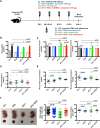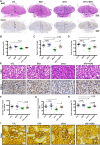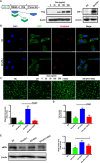Human umbilical cord mesenchymal stem cell derived exosomes (HUCMSC-exos) recovery soluble fms-like tyrosine kinase-1 (sFlt-1)-induced endothelial dysfunction in preeclampsia
- PMID: 37559150
- PMCID: PMC10413730
- DOI: 10.1186/s40001-023-01182-8
Human umbilical cord mesenchymal stem cell derived exosomes (HUCMSC-exos) recovery soluble fms-like tyrosine kinase-1 (sFlt-1)-induced endothelial dysfunction in preeclampsia
Abstract
Background: Preeclampsia is a unique multisystem disorder that affects 5-8% of pregnancies. A high level of soluble fms-like tyrosine kinase-1 (sFlt-1) is a hallmark of preeclampsia that causes endothelial dysfunction. Exosomes derived from mesenchymal stem cells (MSCs) have been indicated to improve endothelial performances by transporting signals to target cells. We hypothesized that exosomes derived from MSCs have potential effects against preeclampsia.
Methods: We collected human umbilical cord MSC-derived exosomes (HUCMSC-exos) by ultracentrifugation. The size and morphology of the exosomes were examined using a transmission electron microscope and nanoparticle tracking analysis. Pregnant mice were injected with murine sFlt-1 adenovirus to build the preeclampsia-like mouse model and then treated with HUCMSC-exos. Human umbilical vein endothelial cells (HUVECs) were infected with lentiviruses expressing tet-on-sFlt-1 to obtain cells overexpressing sFlt-1. Cell proliferation and migration assays were used to measure the endothelial functions. The exosomes enriched proteins underlying mechanisms were explored by proteomic analysis.
Results: In the current study, we successfully collected the cup-shaped HUCMSC-exos with diameters of 30-150 nm. In the sFlt-1-induced preeclampsia mouse model, HUCMSC-exos exhibited beneficial effects on adverse birth events by decreasing blood pressure and improving fetal birth weight. In addition, preeclamptic dams that were injected with HUCMSC-exos had rebuilt dense placental vascular networks. Furthermore, we observed that HUCMSC-exos partially rescued sFlt-1-induced HUVECs dysfunction in vitro. Proteomics analysis of HUCMSC-exos displayed functional enrichment in biological processes related to vesicle-mediated transport, cell communication, cell migration, and angiogenesis.
Conclusion: We propose that exosomes derived from HUCMSCs contain abundant Versican and play beneficial roles in the birth outcomes of sFlt-1-induced preeclamptic mice by promoting angiogenesis.
Keywords: Angiogenesis; Exosomes; Mesenchymal stem cell; Preeclampsia; Soluble fms-like tyrosine kinase-1/sFlt-1.
© 2023. BioMed Central Ltd., part of Springer Nature.
Conflict of interest statement
The authors declare that they have no competing interests.
Figures





Similar articles
-
Exosomes From Women With Preeclampsia Induced Vascular Dysfunction by Delivering sFlt (Soluble Fms-Like Tyrosine Kinase)-1 and sEng (Soluble Endoglin) to Endothelial Cells.Hypertension. 2018 Dec;72(6):1381-1390. doi: 10.1161/HYPERTENSIONAHA.118.11706. Hypertension. 2018. PMID: 30571229
-
Protective effect of human umbilical cord mesenchymal stem cell exosomes on preserving the morphology and angiogenesis of placenta in rats with preeclampsia.Biomed Pharmacother. 2018 Sep;105:1240-1247. doi: 10.1016/j.biopha.2018.06.032. Epub 2018 Jun 22. Biomed Pharmacother. 2018. PMID: 30021360
-
The protective mechanism of human umbilical cord mesenchymal stem cell-derived exosomes against neutrophil extracellular trap-induced placental damage.Placenta. 2024 Aug;153:59-74. doi: 10.1016/j.placenta.2024.05.136. Epub 2024 May 28. Placenta. 2024. PMID: 38823320
-
Extracellular vesicle-loaded hydrogels for tissue repair and regeneration.Mater Today Bio. 2022 Dec 21;18:100522. doi: 10.1016/j.mtbio.2022.100522. eCollection 2023 Feb. Mater Today Bio. 2022. PMID: 36593913 Free PMC article. Review.
-
The potential therapeutic effect of human umbilical cord mesenchymal stem cell-derived exosomes in bronchopulmonary dysplasia.Life Sci. 2024 Nov 15;357:123047. doi: 10.1016/j.lfs.2024.123047. Epub 2024 Sep 12. Life Sci. 2024. PMID: 39260518 Review.
Cited by
-
Decreased Extracellular Vesicle Vasorin in Severe Preeclampsia Plasma Mediates Endothelial Dysfunction.J Am Heart Assoc. 2025 Apr;14(7):e037242. doi: 10.1161/JAHA.124.037242. Epub 2025 Mar 21. J Am Heart Assoc. 2025. PMID: 40118804 Free PMC article.
-
Knowledge mapping of exosomes in preeclampsia: a bibliometric analysis (2008-2023).Front Endocrinol (Lausanne). 2025 Mar 4;16:1546554. doi: 10.3389/fendo.2025.1546554. eCollection 2025. Front Endocrinol (Lausanne). 2025. PMID: 40104134 Free PMC article. Review.
-
Biomarkers and diagnostic significance of non-coding RNAs in extracellular vesicles of pathologic pregnancy.J Assist Reprod Genet. 2024 Oct;41(10):2569-2584. doi: 10.1007/s10815-024-03268-6. Epub 2024 Sep 24. J Assist Reprod Genet. 2024. PMID: 39316328 Review.
-
Mesenchymal stem cell-derived exosomes: a promising alternative in the therapy of preeclampsia.Stem Cell Res Ther. 2024 Feb 5;15(1):30. doi: 10.1186/s13287-024-03652-0. Stem Cell Res Ther. 2024. PMID: 38317195 Free PMC article. Review.
-
MLL1 promotes placental trophoblast ferroptosis and aggravates preeclampsia symptoms through epigenetic regulation of RBM15/TRIM72/ADAM9 axis.Biol Direct. 2024 Dec 22;19(1):133. doi: 10.1186/s13062-024-00572-0. Biol Direct. 2024. PMID: 39709463 Free PMC article.
References
-
- Souza JP, Gülmezoglu AM, Vogel J, Carroli G, Lumbiganon P, Qureshi Z, et al. Moving beyond essential interventions for reduction of maternal mortality (the WHO Multicountry Survey on Maternal and Newborn Health): a cross-sectional study. Lancet. 2013;381(9879):1747–1755. doi: 10.1016/s0140-6736(13)60686-8. - DOI - PubMed
MeSH terms
Substances
Grants and funding
LinkOut - more resources
Full Text Sources
Miscellaneous

